11 Different Types of Solitaire Games to Test Your Skills
Solitaire has been around since the 18th century, and in that time the game has evolved into hundreds of different variations. If you’ve mastered the classic version and want to try a more difficult type of Solitaire, you’ve come to the right place.
This article explains the rules for 11 common Solitaire games including Klondike, FreeCell, Pyramid, Golf, Yukon, Forty Thieves, Spider, Canfield, and more. You can play them all online for free on Solitaire Bliss!
Types of Solitaire (Easiest to Hardest)
Easier types of Solitaire like Spider Solitaire and FreeCell have simple sequencing rules and maneuverability, while complex variations have stricter rules and limited movements. While the goal of most Solitaire games is to complete the foundation piles, how you do so differs. We break down key features of popular Solitaire variations to help you choose the best one for your skillset.
| Solitaire Variation | Key Concepts | Win Rate |
|---|---|---|
| Klondike | Build descending, alternating-color sequences; cycle through the stockpile when you get stuck. | 35% |
| Spider Solitaire | Build complete (king to ace) same-suit descending sequences in the tableau. | 60% (1 Suit) |
| FreeCell | Use four free cells to help rearrange cards. | 33% |
| Tri Peaks | Pair cards that are one rank higher or lower than the top foundation pile card. | 16% |
| Yukon | Move any card and all cards below it onto a higher card of the opposite color. There’s no stockpile or waste pile. | 12% |
| Canfield | With a reserve pile of 13 cards, the base card determines what foundations start with. | 7% |
| Forty Thieves | Only move one card at a time in the tableau with one pass through the stockpile. | 5% |
| Scorpion | Build complete (king to ace) same-suit descending sequences in the tableau; the stack below the sequenced card moves with it. | 5% |
| Golf | Pair cards one rank higher or lower than the foundation with only one pass through the stockpile. | 3% |
| Crescent | The crescent-shaped tableau has multiple hidden cards; of eight foundation piles, build four in ascending order and build four in descending order. | 40.1% |
| Pyramid | Pair cards to total 13. | 49.6% |
1. Klondike Solitaire
Klondike Solitaire, also known as Classic Solitaire, is the most popular variation. Using one standard deck of playing cards, the goal is to move all the cards to four foundation piles ascending from ace to king by suit (hearts, diamonds, clubs, and spades). Turn 1 is easier because you can access all cards in the stockpile, while Turn 3 adds the challenge of cycling through the stock in sets of three, limiting your immediate access to certain cards.
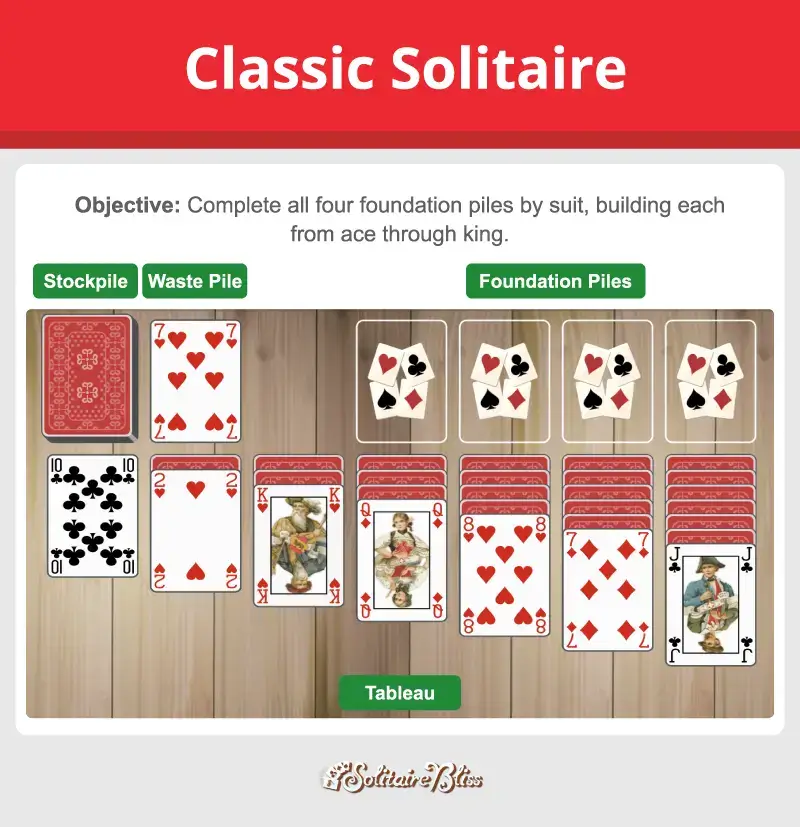
How to Play
- Setup: To set up the tableau, deal seven columns from left to right, placing one card in the first column, two in the second, three in the third, and continuing until the seventh column has seven cards. Turn the last card of each column face up.
- Sequencing: Sequence face-up cards in descending order, alternating color. For example, a three of hearts could go on top of a four of spades. When you remove a face-up card from a column, flip over the facedown card underneath.
- Stockpile: The remaining cards form the stockpile. When you get stuck, flip cards from the stockpile to the waste pile to use in gameplay. You can run through the stockpile as many times as you want.
- Waste pile: You can only use the top card of the waste pile to sequence cards in the tableau or foundation piles. After you use a card, the next card in the waste pile becomes available.
- Empty columns: Only kings or sequences that begin with kings can fill empty columns.
- Foundation piles: Four foundation piles sit above the tableau—one for each suit. You win the game by moving all the cards to the foundation piles from ace to king in ascending order (ace, then two, then three, and so on).
2. Spider Solitaire
Spider Solitaire uses 104 cards and is unique because you must build complete descending same-suit sequences (king to ace) in the tableau before moving them to foundation piles. There are three types of Spider Solitaire—1 Suit, 2 Suits, and 4 Suits—ranging from easy to advanced.
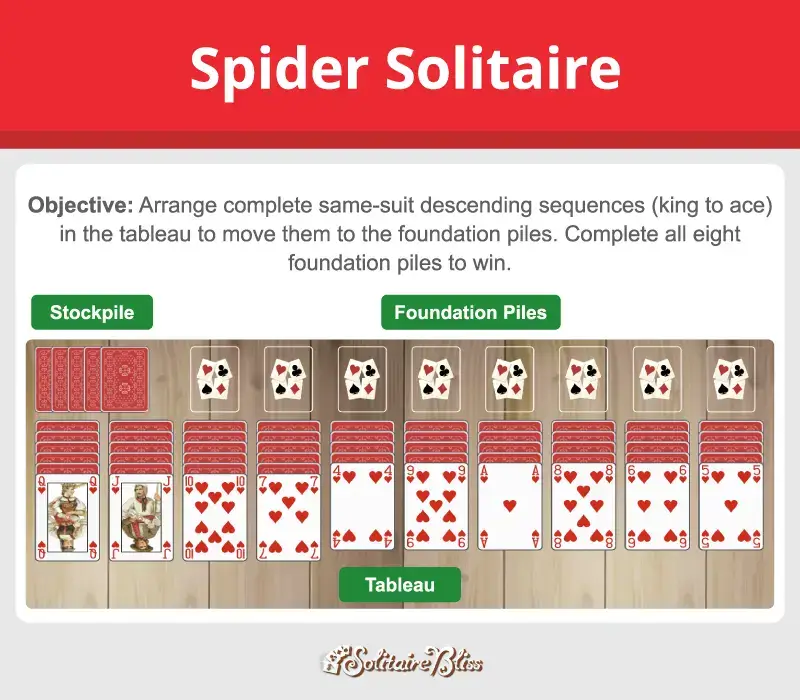
How to Play
- Setup: The tableau consists of 10 columns. The first four columns have six cards each and the next six have four cards each, with the last card of each column face up. The remaining cards are placed in a stockpile.
- Sequencing: You can sequence cards in descending order regardless of suit. However, only same-suit sequences can be moved as a group, and because completed same-suit sequences are moved to the foundation piles, they are the priority.
- Stockpile: When you use the stockpile, a card is dealt to the bottom of each column. Since there are 50 cards in it, it can be used five times. Each column must have at least one card in order to use the stockpile.
- Empty columns: Move any card or sequence into an empty column.
- Foundation piles: To move cards to the foundation piles, you must complete same-suit sequences (king to ace) in the tableau. When you complete all eight piles, you win.
3. FreeCell Solitaire
FreeCell is an easy version of Solitaire because all the cards are face-up, which removes unknowns and allows you to plan your moves. Like Klondike Solitaire, you build the four foundation piles by suit (from ace to king) to win. The major difference is that you have no stockpile. Instead, there are four free cells to help you arrange cards.
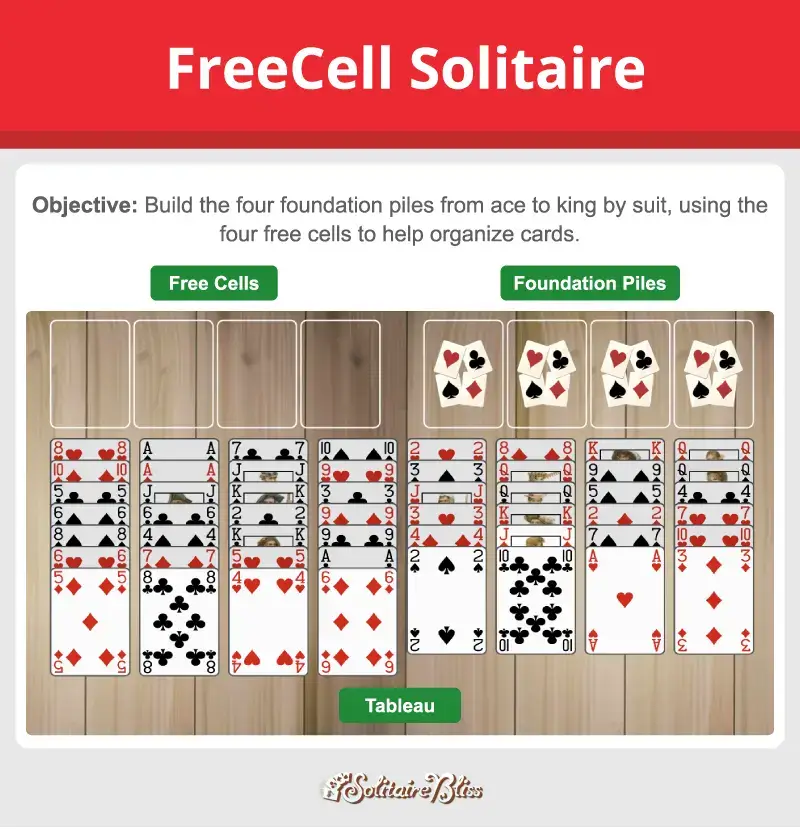
How to Play
- Setup: To create the eight-column tableau, deal seven face-up cards each into the first four columns and six face-up cards each into the remaining four columns.
- Sequencing: Sequence cards in descending order and alternating color.
- Free cells: Use free cells to temporarily hold cards, so you can access buried cards in the tableau. You can only move sequences equal to the number of free cells plus one, so if three free cells are open, you can move a sequence of up to four cards.
- Empty columns: Move any card or sequence to an empty column.
- Foundation piles: As in Classic Solitaire, you win by completing all four suited foundation piles. Each pile starts with an ace and is stacked in ascending order, ending with the king.
If you need an in-depth tutorial, check out our guide on how to play FreeCell and learn more about FreeCell strategies.
4. Tri Peaks Solitaire
Tri Peaks gets its name because the tableau is shaped like three mountain peaks. Similar to Golf, in Tri Peaks you remove cards from the tableau if they are one rank higher or lower than the top foundation pile card and clear the tableau to win.
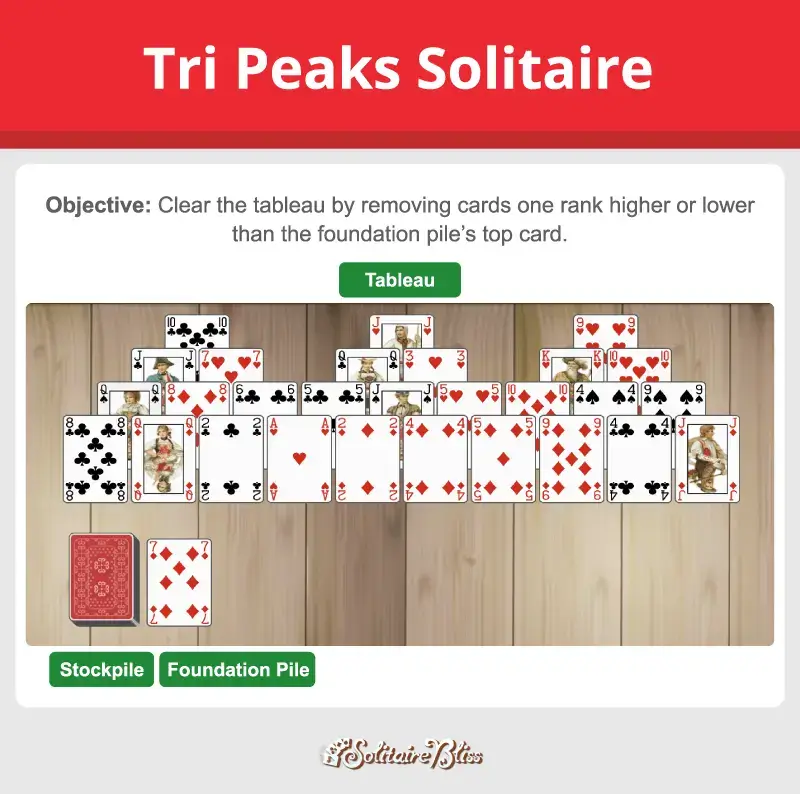
How to Play
- Setup: Lay out three peaks using 28 face‑up cards in four rows (3‑6‑9‑10). Place the remaining cards facedown as the stockpile and turn the top card face up to start the foundation pile.
- Pairing: Select any exposed tableau card that is one rank higher or lower than the foundation pile card and place it on the foundation. Use this new card for the next pairing.
- Stockpile: If you can’t make a move, flip a card from the stock to the foundation. You can only cycle through the stockpile once, so don’t draw from it unless you need to.
- Foundation pile: Pairing occurs in the foundation pile. Move all cards from the tableau to the foundation to win.
5. Yukon Solitaire
Yukon Solitaire is more difficult than Klondike because you have no stockpile, and when you move a card in the tableau, you also move all the cards stacked beneath it, no matter what order they’re in. Like other building Solitaire games, the goal is to complete all four suited foundation piles from ace to king.
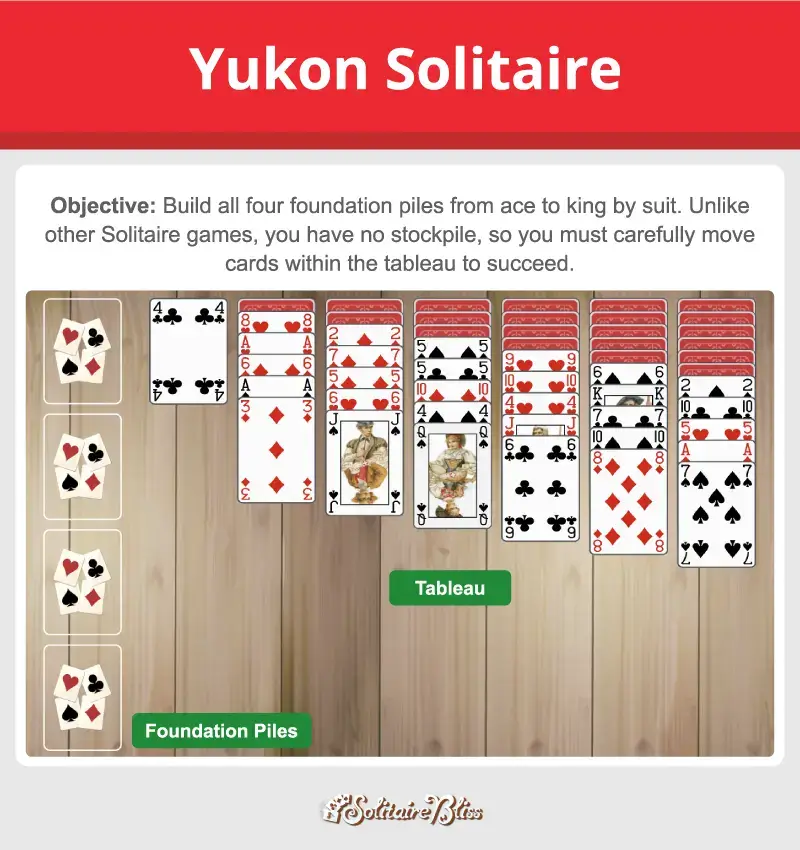
How to Play
- Setup: The tableau consists of seven columns of 52 cards. The leftmost column has one face‑up card. Each subsequent column adds one facedown card and ends with five face‑up cards.
- Sequencing: Build descending sequences of alternating colors. If the face-up card you want to move has cards on top of it, you move the whole group together. For example, if one column has a five of clubs and nine of diamonds and another ends with a six of hearts, you can move the five and nine onto the six.
- Empty columns: Empty columns can be filled only with a king or a properly sequenced stack starting with a king.
- Foundation piles: Build foundation piles from ace to king by suit as cards become available in the tableau.
6. Canfield Solitaire
Canfield is a challenging Solitaire type that includes multiple unique elements, including a reserve pile and foundation piles that begin with a randomly drawn base card. For instance, if the three of diamonds is dealt to the leftmost foundation pile, then you must begin the other three foundation piles with the three of each suit. The foundations are then built up in ascending order by suit, wrapping from king to ace if needed.
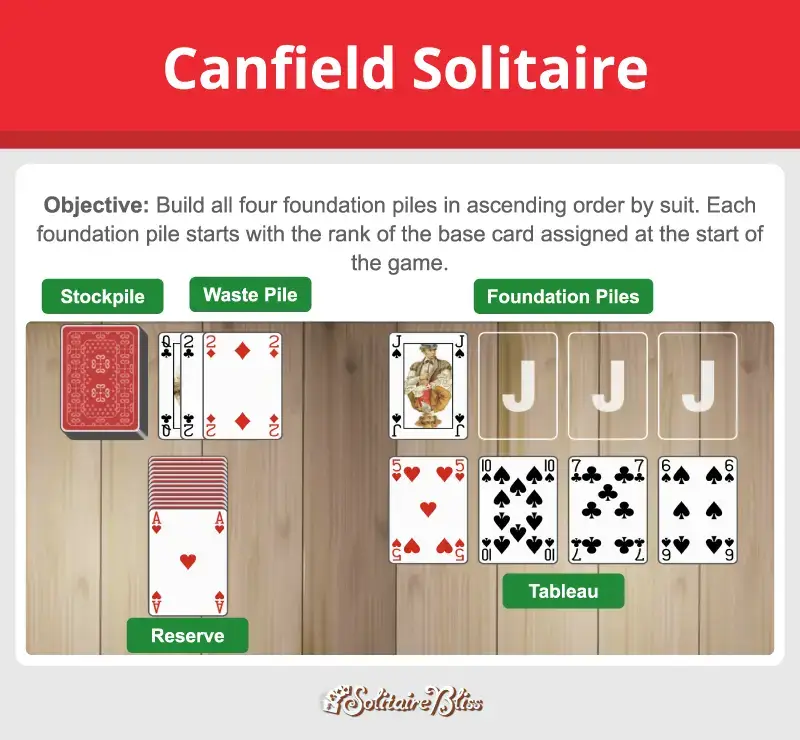
How to Play
- Setup: Using a standard deck, deal 13 cards into the reserve pile, turning the top card face up. Deal one face-up card to each of the four tableau columns, then flip one card to start the first foundation pile as the base card. Place the remaining cards in the stockpile.
- Sequencing: Sequence cards in descending order, alternating color. Ranks can wrap, meaning that a king can be placed on an ace in the tableau.
- Stockpile: Flip cards from the stockpile to the waste pile when you get stuck. Similar to Turn 3, three cards are flipped from the stockpile at a time. You can run through the stockpile as many times as you need.
- Waste pile: You can only play the top card of the waste pile, but after you use it, the next card becomes available to play.
- Reserve pile: Reserve cards are used to fill empty columns. They can also be placed in tableau columns or the foundation piles. When the reserve runs out, you can fill columns with stockpile cards.
- Foundation piles: Build foundation piles in ascending order by suit. Foundation piles must each start with the base card determined at the start of the game.
7. Forty Thieves Solitaire
Forty Thieves Solitaire is named for the 40 cards dealt into the tableau—10 columns with four cards each. Played with two decks, it’s considered an advanced variation because you can only move one card at a time and may only go through the stockpile once.
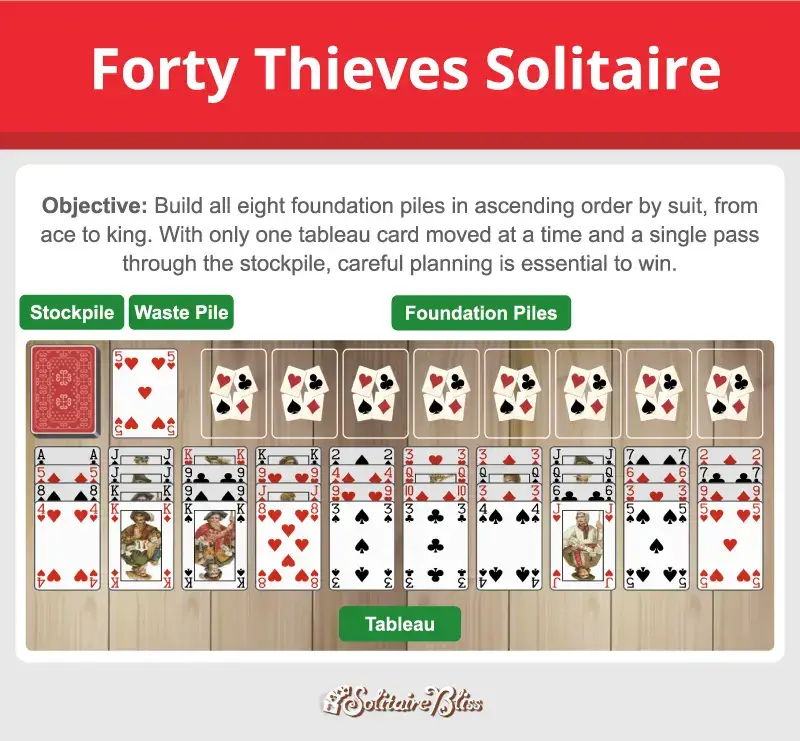
How to Play
- Setup: Deal 10 columns of four face-up cards each into the tableau and place the remaining cards facedown in the stockpile.
- Sequencing: Sequence same-suit cards in descending order. You can only move one card at a time in the tableau.
- Stockpile use: Flip a card from the stockpile to the waste pile when you get stuck. You can only run through the stockpile once.
- Waste pile: Waste pile cards can be moved to the tableau or foundation piles, and only the top card is available to play.
- Empty columns: Move any card into an empty column.
- Foundation piles: Complete all eight foundation piles from ace to king by suit to win. If you run out of moves before the foundation piles are built, the game is over.
8. Scorpion Solitaire
Scorpion is an advanced Solitaire game that blends Spider and Yukon. Like Spider, you must build descending same-suit sequences in the tableau before moving them to the foundation piles. Like Yukon, you can move any face-up card along with all the cards stacked beneath it, as long as you place it on a card that is one rank higher in the same suit.
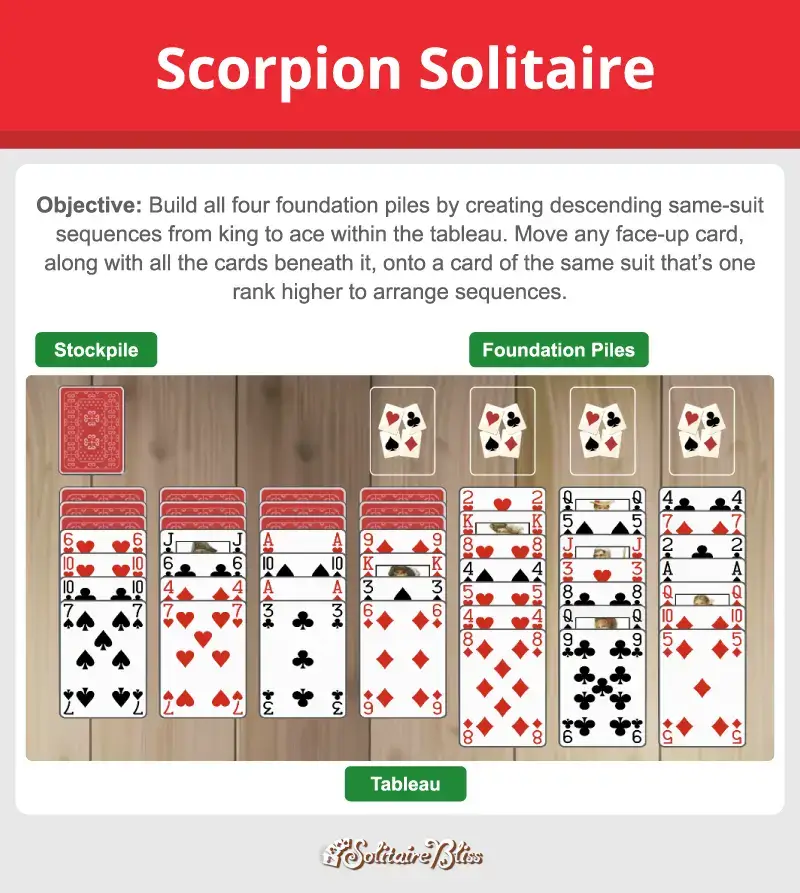
How to Play
- Setup: Deal seven tableau columns with seven cards each. In the first four columns, the first three cards are face down and the remaining cards are face up. In the remaining three columns, all cards are face up. Place the last three cards in the stockpile.
- Sequencing: Build descending sequences by suit. You may move any face‑up card and all cards below it as a single unit if the first card can be placed on a card of the same suit that’s one rank higher.
- Stockpile: When no moves are available, flip the three stock cards onto the first three columns.
- Empty columns: Only kings or sequences that begin with kings can move to empty columns.
- Foundation piles: Assemble same-suit king-to-ace sequences in the tableau. Once a sequence is complete it moves to a foundation pile. Complete all four piles to win.
9. Golf Solitaire
The goal of Golf Solitaire is to clear the tableau by pairing cards that are one rank higher or lower than the top foundation pile card. While you can only run through the stockpile once, all the tableau cards are face up, allowing you to strategically plan your moves.
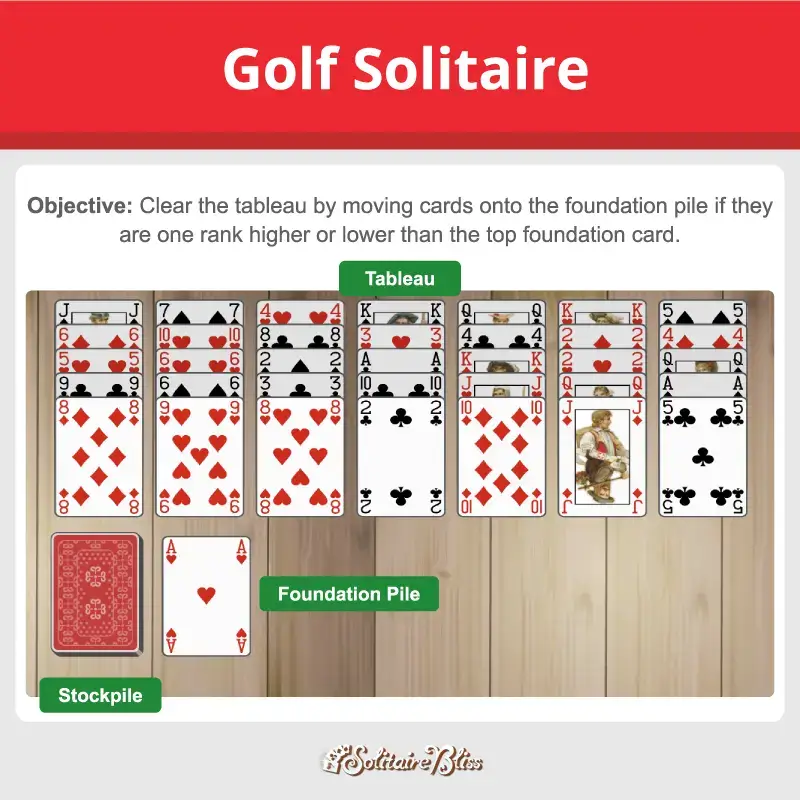
How to Play
- Setup: Deal seven columns of five face-up cards each. The remaining cards are placed in a stockpile below the tableau. Turn one card face-up to begin your foundation pile.
- Pairing: Remove any exposed tableau card that is one rank higher or lower than the top foundation pile card. Suits don’t matter in Golf, but ranks can’t wrap, meaning you can’t place a king on an ace or ace on a king.
- Stockpile use: If no moves are available, flip the next stock card onto the foundation pile. You can only cycle through the stockpile once, so only draw from it when you’re stuck.
- Foundation pile: To win, you must move all the cards from the tableau to the foundation pile. The game ends when you clear the tableau or no more moves remain.
10. Crescent Solitaire
Crescent Solitaire is a unique two-deck game with a crescent-shaped tableau. There are eight foundation piles, four that ascend from ace to king and four that descend from king to ace. Tableau piles can also be built in ascending or descending order, making it essential to keep track of the direction of each pile to plan your moves carefully and avoid blocking key cards.
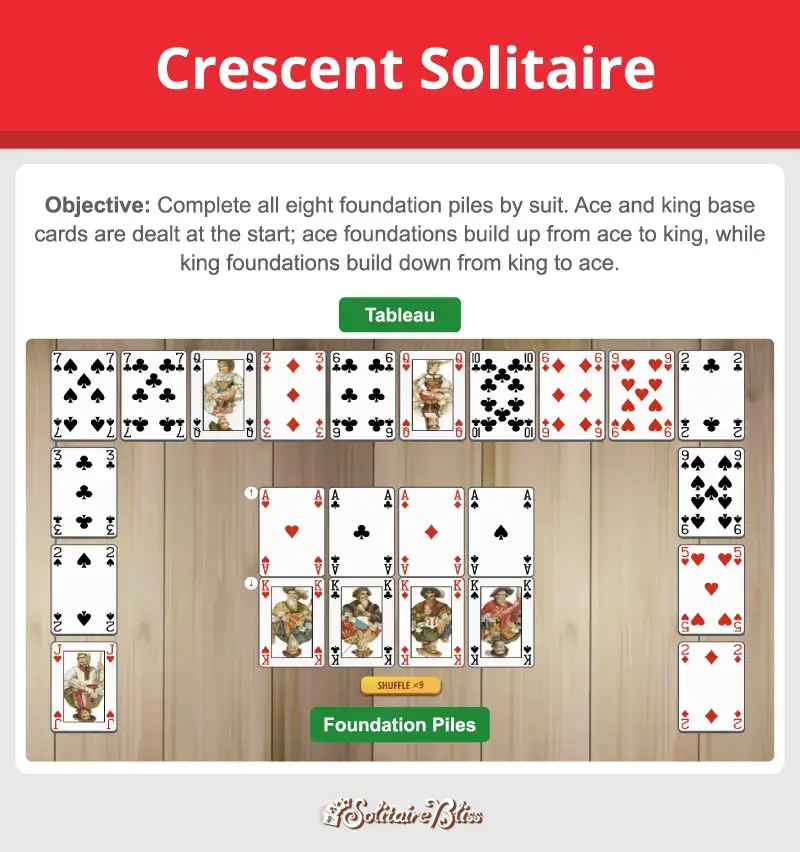
How to Play
- Setup: Deal four foundation piles that start with ace and four that start with king. Deal the remaining 96 cards into 16 tableau piles of six cards each arranged in a crescent around the foundation piles.
- Moves: You can move cards from tableau to foundation, between tableau piles, from foundation back to tableau, and between foundation piles. Tableau cards may be sequenced by suit in ascending or descending order, and you can wrap ranks (place a king on an ace or vice versa).
- Shuffling: If no moves are available, you can use the shuffle button to move the bottom card of each tableau pile to the top. Solitaire Bliss allows you to shuffle cards nine times.
- Empty spaces: You cannot fill empty tableau spaces with new cards.
- Foundation piles: Four foundation piles ascend from ace to king by suit and four descend from king to ace. Complete all eight piles to win.
11. Pyramid Solitaire
In Pyramid Solitaire, you must clear the pyramid-shaped tableau by pairing cards that add up to 13. You can only run through the stockpile once, making this a difficult variation that requires both luck and strategy.

How to Play
- Setup: Deal one face-up card at the top of the pyramid, followed by two face-up cards slightly overlapping the first card, and so on until there are seven rows of 28 cards.
- Pairing: Pair uncovered cards that add up to 13 and place them into the foundation pile. You can pair tableau cards with each other or with the waste pile card. Numbered cards equal their face value, aces are one, jacks are 11, queens are 12, and kings are 13 (and can go directly to the foundation pile without needing a pair).
- Stockpile use: Flip a card from the stockpile to the waste pile when you need more pairing options. Use the stockpile sparingly because it can only be run through once.
- Waste pile: You can use the top card of the waste pile to pair with cards in the tableau. If you use a waste pile card, the next card in the waste pile is available to use.
- Foundation pile: Paired cards are placed in the foundation pile. If you clear the tableau of all cards, you win.
If you’re ready to try a new type of Solitaire game, Solitaire Bliss is a great place to start! We offer free online Solitaire for both beginners and advanced players.
Back to the Homepage

